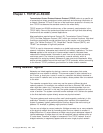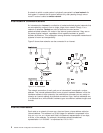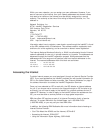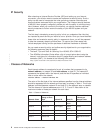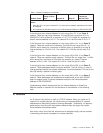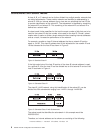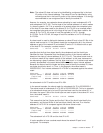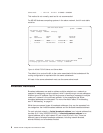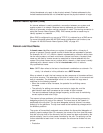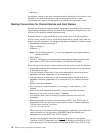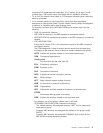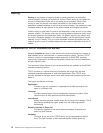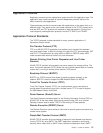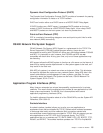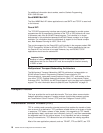
Limited broadcasts only apply to the physical network. Packets addressed to the
limited broadcast address are not forwarded beyond the physical network of origin.
Domain Name System (DNS)
An Internet address is used to establish a connection between your system and
another system in a network. Because Internet addresses can sometimes be
difficult to remember, another naming convention is used. This naming convention is
called the Domain Name System (DNS). DNS names provide an easier way to
identify systems in a network.
When DNS is configured to run as part of TCP/IP, it is referred to as a DNS server.
For more information about AS/400 DNS server configuration and functions, see
“Chapter 18. AS/400 Domain Name System (DNS)” on page 421.
Domain and Host Name
A domain name identifies where your system is located within a hierarchy of
groups of systems. Domain names consist of labels that are separated by periods
(for example, ABC.DEF.XYZ). Within a domain represented by a domain name, there
can be many systems, and each must have a unique host name. A system’s host
name can be used by remote servers to associate an Internet address with the
system. Since host names are only unique within a domain, a host name is usually
combined with a domain name in the form host.domain, which is called a
fully-qualified host name.
Note: SMTP often refers to the host or host.domain combination as a domain. For
clarity, it is refered to in this publication as a SMTP domain.
When a network is small, the host names can be a sequence of characters without
any further structure. The advantage of this kind of name is that it is convenient and
easy to remember. The disadvantage is that it is not suitable for large sets of
machines for the following reasons:
v When the number of sites increases, the potential for conflicting names
increases.
v The authority for adding new names must rest at a single site, and the
administrative work load increases as the number of sites increase.
v The name-to-address bindings change frequently, and the cost of maintaining
correct copies at each site is high.
The answer to these problems is the decentralization of the naming process by
delegating authority for parts of the network. The name area of the network is
partitioned at the top level. The top level delegates authority (where it has some
authority) for the partitions. The top level need not be bothered by changes within
the different partitions.
The syntax of hierarchically assigned names reflects the hierarchical delegation of
authority used to assign them. For example, the names of the form
local.site
mean
that
site
is the top level of the hierarchy and this name has been authorized by the
central authority;
local
is a host name controlled by the
site
. The authority can be
further subdivided at each level. In this example, the
site
can be divided into two
groups:
v Production
Chapter 1. TCP/IP on AS/400 9



